The Sèvre Nantaise is a river in western France, a left-bank tributary to the Loire. Its total length is 142 km. Its source is in the Deux-Sèvres département, near Secondigny.
CLICK Refresh FOR SLIDES
The Sèvre Nantaise is a river in western France, a left-bank tributary to the Loire. Its total length is 142 km. Its source is in the Deux-Sèvres département, near Secondigny.
CLICK Refresh FOR SLIDES

Grand old gardens seem to assert the outer borders of Nantes in each direction but it is to the North that is located a roseraie for all seasons with ample flowering year round, baroque old roses in the warmer months aside hardy new roses which still flower in the cold months. One could live in Nantes for this garden alone.


HISTORY
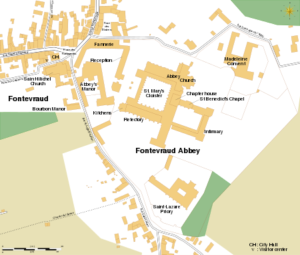
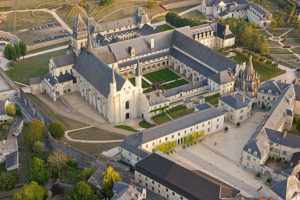
The following is from Wikipedia
Founder
Robert of Arbrissel had served as the Archpriest of the Diocese of Rennes, carrying out the reformist agenda of its bishop. When the bishop died in 1095, Robert was driven out of the diocese due to the hostility of the local clergy. He then became a hermit in the forest of Craon, where he practiced a life of severe penance, together with a number of other men who went on to found major monastic institutions. His eloquence and asceticism attracted many followers, for whom in 1096 he founded a monastery of canons regular at La Roë, of which he was the first abbot. In that same year Pope Urban II summoned him to Angers and appointed him an apostolic missionary, authorizing him to preach anywhere. His preaching drew large crowds of devoted followers, both men and women, even lepers. As a result, many men wished to embrace the religious life, whom he sent to his abbey. When the canons of that house objected to the influx of candidates of lower social states, he resigned his office and left the community.
Fontevraud
Around 1100 Robert and his followers settled in a valley called Fons Ebraldi where he established a monastic community. Initially the men and women lived together in the same house, in an ancient ascetic practice called Syneisaktism. This practice had been widely condemned by Church authorities, however, and under pressure the community soon segregated according to gender, with the monks living in small priories where they lived in community in service to the nuns and under their rule. They were recognized as a religious community in 1106, both by the Bishop of Angers and by Pope Paschal II. Robert, who soon resumed his life of itinerant preaching, appointed Hersende of Champagné to lead the community. Later her assistant, Petronilla of Chemillé, was elected as the first abbess in 1115.
Robert wrote a brief Rule of Life for the community, based upon the Rule of St. Benedict. Unlike the other monastic orders characterized by double monasteries, the monks and nuns of the Order of Fontevrault followed the same Rule. In his Rule, Robert dealt with four principal points: silence, good works, food and clothing, encouraging the utmost in simplicity of life and dress. He directed that the abbess should never be chosen from among those who had been brought up at Fontevrault, but that she should be someone who had had experience of the world (de conversis sororibus). This latter injunction was observed only in the case of the first two abbesses and was canceled by Pope Innocent III in 1201. At the time of Robert’s death in 1117, there were about 3,000 nuns in the community.
In the early years the Plantagenets were great benefactors of the abbey and while Isabella d’Anjou was the abbess, King Henry II’s widow, Eleanor of Aquitaine, made the abbey her place of residence. Abbess Louise de Bourbon left her crest on many of the alterations to the abbey building which she made during her term of office.
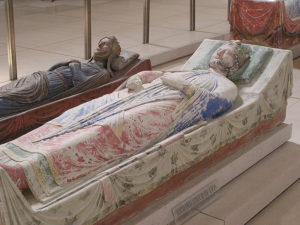
Tomb of Richard I of England (front) and Isabella of Angoulême (back)
Decline
With the passing of the Plantagenet dynasty, however, Fontevrault and her dependencies began to fall upon hard times. At the end of the 12th century, the Abbess of Fontevrault, Matilda of Flanders (1189-1194), complained about the extreme poverty which the abbey was suffering. As a result, in 1247 the nuns were permitted to receive inheritances to provide income for their needs, contrary to monastic custom. The fragile economic basis of the Order was exacerbated by the devastation of the Hundred Years War, which lasted throughout the 14th century. A canonical visitation of fifty of the priories of the Order in 1460 showed most of them to be barely occupied, if not abandoned.

Abbess Louise Françoise de Rochechouart (1664-1742)

Abbess Gabrielle de Rochechouart (1645-1704)
Suppression
The Order was dispersed during the French Revolution. In November 1789, all property of the Catholic Church was declared to be the property of the nation. On 17 August 1792, a Revolutionary decree ordered evacuation of all monasteries, to be completed by 1 October 1792. At that time, there were still some 200 nuns and a small community of monks in residence at Fontevraud. The last abbess, Julie Sophie Charlotte de Pardaillan d’Antin, is said to have died in poverty in Paris in 1797. The abbey later became a prison from 1804 to 1963, when it was given to the French Ministry of Culture.
The projected prison in the former abbey was planned to hold 1,000 prisoners, and required major changes, including new barracks in addition to the transformation of monastic buildings into dormitories, workshops, and common areas. Prisoners–-men, women and children-–began arriving in 1814. Eventually, it held some 2,000 prisoners, earning the prison the reputation of being the “toughest in France after Clairvaux”. Political prisoners experienced the harshest conditions: some French Resistance prisoners were shot there under the Vichy Government. Following the closing of the prison came a major restoration, and opening to the public in 1985, with completion of the abbey church’s restoration in 2006 under architect Lucien Magne.
CLICK Refresh FOR SLIDES
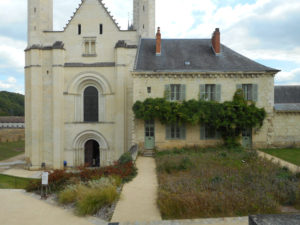
The Royal Abbey of Our Lady of Fontevraud or Fontevrault (in French: abbaye de Fontevraud) was a monastery in the village of Fontevraud-l’Abbaye, near Chinon, in Anjou, France. It was founded in 1101 by the itinerant preacher Robert of Arbrissel. The foundation flourished and became the center of a new monastic Order, the Order of Fontevrault. This order was composed of double monasteries, in which the community consisted of both men and women—in separate quarters of the abbey—all of which were subject to the authority of the Abbess of Fontevraud. The Abbey of Fontevraud itself consisted of four separate communities, all completely managed by the same abbess.
The first permanent structures were built between 1110 and 1119.[1] The area where the Abbey is located was then part of what is sometimes referred to as the Angevin Empire. The King of England, Henry II, his wife, Eleanor of Aquitaine, and son, King Richard the Lionheart were all buried here at the end of the 12th century. It was disestablished as a monastery during the French Revolution.
A UNESCO World Heritage Site, it is situated in the Loire Valley between Chalonnes-sur-Loire and Sully-sur-Loire within the Loire-Anjou-Touraine French regional natural park (Parc naturel régional Loire-Anjou-Touraine).
The complex of monastic buildings served as a prison from 1804 to 1963. Since 1975, it has hosted a cultural centre, the Centre Culturel de l’Ouest.
CLICK Refresh FOR SLIDES
CLICK Refresh FOR SLIDES


The Pays de la Loire region is a recent creation, not one of France’s historic regions. Indeed, the regional capital, Nantes, was once the capital of Brittany – to which it no longer belongs. In historic terms, Pays de la Loire covers parts of the old provinces of Brittany, Anjou, Maine and Poitou. The Pays de la Loire covers the area to the south of Brittany and Normandy, along the lower stretches of the river Loire, the longest river in France.
The region is composed of five departments, two of them coastal – the Loire Atlantique (44) and the Vendée (85) – and three of them inland, the Mayenne (53), the Sarthe (72) and the Maine et Loire (49).

Nantes (44), the regional capital is the sixth largest city in France, with 270,000 inhabitants in the urban borough of Nantes, and an estimated 800,000 inhabitants in the urban area as of 2008. It is located on the Loire, 50 km inland, and is the largest economic hub in the north west of France. In the eighteenth century, Nantes (like Bristol) was a flourishing seaport, indeed the most important seaport in France; the city acquired great wealth at that time, wealth which is reflected to this day in its urban heritage. Today, most of the shipping activity has moved to the mouth of the Loire, to the port of Saint Nazaire, which is also one of the major ship-building cities in Europe. It was in the Saint Nazaire dockyards that the new flagship of the Cunard line, the world’s largest passenger ship, the Queen Mary 2, was built. A clear birds-eye view of the shipyards can be had from the Pont de Saint Nazaire, the high road bridge that spans the Loire estuary. (Originally a toll bridge, this bridge is now free to cross).
On the coast of the Loire Atlantique department lie two of France’s historic seaside resorts, La Baule and Le Croisic. The area round Le Croisic is also famous for its salt pans, and “sel de Guérande” is one of the best-known types of salt in France. The town of Guérande is a delightful small ancient walled city, just inland from the salt marshes.
South of the Loire Atlantique department lies an area known as Vendée. The modern department (85) is much smaller than the historic area that once carried this name. Vendée is famous in the history of France as one of the old bastions of Protestantism; after the revocation of the Edict of Nantes in 1685, and the end of religious tolerance, tens of thousands of Vendéen protestants fled from this part of France, and went to live in England, or America. Thus many people in England can trace some of their ancestry back to this part of France.
After the French Revolution, Vendée was a centre for the royalist counter-revolution.
The department is largely flat in the northern coastal area, low-lying and gently undulating inland. The capital, the city of La Roche sur Yon, is a small rural city in the middle of the department. The coast is built up round the seaside resorts, notably the fine beaches at les Sables d’Olonne, Saint Gilles Croix-de-Vie and St. Jean de Monts, but elsewhere there are stretches of empty coastline. In parts, a band of pine forests, planted on land that was once sand dunes, protects the flat farmland behind from the Atlantic winds and the sand – and protects it against flooding when Atlantic storms batter the coastline.
Further inland, the department of Maine et Loire (49) covers a territory to the north and south of the Loire.This is the heart of the region known as Anjou, and its capital Angers is one of the great historic cities in the Loire valley. Anjou was the fief of the Angevins, better known as the Plantagenets, who, starting with Henry II, ruled England for three centuries. The great castle of the counts of Anjou, in Angers, is one of the biggest medieval fortresses in Europe. Henry II, his wife Eleanor of Aquitaine, and their son Richard the Lionheart are buried at the Abbey of Fontevraud, between Saumur and Chinon.
The two remaining departments of this region, Sarthe (72) and Mayenne (53) form the rest of the old provinces of Anjou and Maine, and border on Normandy. Rural departments, and strongly agricultural, they both have more in common with Normandy than they do with Vendée. Half the population of the department of the Sarthe lives in the urban area round the capital, Le Mans, famous for its annual motor race. Apart from that, the Sarthe is deeply rural. La Flèche, an attractive small town on the river Loir (without an -e !) boasts one of the best and oldest zoos in France, coverning some 30 acres. Laval, capital of the Mayenne, is a small city with a historic centre. The city is located on the banks of the river Mayenne, which crosses the department from north to south, a navigable waterway with opportunities for boat hire, and 85 km of towpath idel for cyclists and hikers. The department of the Mayenne also boasts the highest point in the northwest quarter of France, the summit of the Mont des Avaloirs, at 417 metres, about 1350 ft.
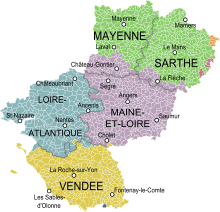
Map of the Pays de la Loire with its five departments
showing the provinces that existed on its territory in the XVIII century.
CLICK Refresh FOR SLIDES
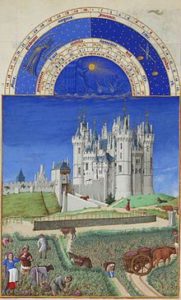
Chateau de Saumur – as pictured in Les Très Riches Heures du duc de Berry in 1410.
Saumur is a town in the Maine-et-Loire département, which is within the Pays de la Loire région in North-Western France on the Loire River. It is known for its cavalry school and for its wines. The town, dominated by the château of the dukes of Anjou, is located on rising ground between the Loire River and its tributary the Thouet, 3 km from their confluence.
Early settlement of the region goes back many thousands of years. Located on the south of the town is France’s largest neolithic megalith. The Dolmen de Bagneux is 23 meters long and built from 15 large slabs of the local stone weighs over 500 tons.
Prior to the French Revolution Saumur was the capital of the Sénéchaussée de Saumur, a bailiwick, which existed until 1793. Saumur was then the location of the Battle of Saumur during the Revolt in the Vendée, becoming a state prison under Napoleon Bonaparte. The town was an equestrian centre with both the military cavalry school from 1783 and later the Cadre Noir based there.
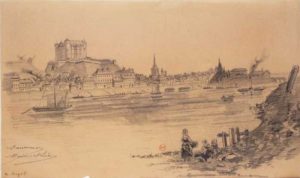
The Château de Saumur was constructed in the 10th century to protect the Loire river crossing from Norman attacks after the settlement of Saumur was sacked in 845. The castle, destroyed in 1067 and inherited by the House of Plantagenet, was rebuilt by Henry II of England in the later 12th century. It changed hands several times between Anjou and France until 1589.
The town’s industries include the processing of the traditional agricultural products of the region (wines, mushrooms, and vegetables), aluminum fabrication, and plastics manufacture. Saumur is also an administrative and service centre. Pop. (1999) 29,857; (2014 est.) 27,301.
CLICK Refresh FOR SLIDES